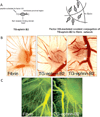Sculpting the blank slate: how fibrin's support of vascularization can inspire biomaterial design
- PMID: 23933102
- PMCID: PMC3864148
- DOI: 10.1016/j.actbio.2013.07.043
Sculpting the blank slate: how fibrin's support of vascularization can inspire biomaterial design
Abstract
Fibrin is the primary extracellular constituent of blood clots, and plays an important role as a provisional matrix during wound healing and tissue remodeling. Fibrin-based biomaterials have proven their utility as hemostatic therapies, scaffolds for tissue engineering, vehicles for controlled release, and platforms for culturing and studying cells in three dimensions. Nevertheless, fibrin presents a complex milieu of signals to embedded cells, many of which are not well understood. Synthetic extracellular matrices (ECMs) provide a blank slate that can ostensibly be populated with specific bioactive cues, including growth factors, growth factor binding motifs, adhesive peptides and peptide crosslinks susceptible to proteases, thereby enabling a degree of customization for specific applications. However, the continued evolution and improvement of synthetic ECMs requires parallel efforts to deconstruct native ECMs and decipher the cues they provide to constituent cells. The objective of this review is to reintroduce fibrin, a protein with a well-characterized structure and biochemistry, and its ability to support angiogenesis specifically. Although fibrin's structure-function relationships have been studied for decades, opportunities to engineer new and improved synthetic hydrogels can be realized by further exploiting fibrin's inspiring design.
Keywords: Angiogenesis; Biomaterial; Extracellular matrix; Fibrin.
Copyright © 2013 Acta Materialia Inc. Published by Elsevier Ltd. All rights reserved.
Figures



Similar articles
-
Fibrin-based biomaterials to deliver human growth factors.Thromb Haemost. 2003 Mar;89(3):573-82. Thromb Haemost. 2003. PMID: 12624643
-
Fibrin-based biomaterials: modulation of macroscopic properties through rational design at the molecular level.Acta Biomater. 2014 Apr;10(4):1502-14. doi: 10.1016/j.actbio.2013.09.008. Epub 2013 Sep 19. Acta Biomater. 2014. PMID: 24056097 Free PMC article. Review.
-
Heparin-binding domain of fibrin(ogen) binds growth factors and promotes tissue repair when incorporated within a synthetic matrix.Proc Natl Acad Sci U S A. 2013 Mar 19;110(12):4563-8. doi: 10.1073/pnas.1221602110. Epub 2013 Mar 4. Proc Natl Acad Sci U S A. 2013. PMID: 23487783 Free PMC article.
-
Modified fibrin hydrogel matrices: both, 3D-scaffolds and local and controlled release systems to stimulate angiogenesis.Curr Pharm Des. 2007;13(35):3597-607. doi: 10.2174/138161207782794158. Curr Pharm Des. 2007. PMID: 18220797 Review.
-
Microfluidic 3D platform to evaluate endothelial progenitor cell recruitment by bioactive materials.Acta Biomater. 2022 Oct 1;151:264-277. doi: 10.1016/j.actbio.2022.08.019. Epub 2022 Aug 15. Acta Biomater. 2022. PMID: 35981686
Cited by
-
Advanced gelatin-based vascularization bioinks for extrusion-based bioprinting of vascularized bone equivalents.Sci Rep. 2020 Mar 24;10(1):5330. doi: 10.1038/s41598-020-62166-w. Sci Rep. 2020. PMID: 32210309 Free PMC article.
-
Engineering fibrin hydrogels to promote the wound healing potential of mesenchymal stem cell spheroids.Acta Biomater. 2017 Dec;64:176-186. doi: 10.1016/j.actbio.2017.10.007. Epub 2017 Oct 5. Acta Biomater. 2017. PMID: 28987783 Free PMC article.
-
Endothelial sprouting and network formation in collagen- and fibrin-based modular microbeads.Acta Biomater. 2016 Jan;29:33-41. doi: 10.1016/j.actbio.2015.10.022. Epub 2015 Oct 23. Acta Biomater. 2016. PMID: 26481042 Free PMC article.
-
Sustained delivery of functional vascular endothelial growth factor from nanoporous silica nanoparticles into a fibrin gel.PLoS One. 2025 Jun 26;20(6):e0326561. doi: 10.1371/journal.pone.0326561. eCollection 2025. PLoS One. 2025. PMID: 40569914 Free PMC article.
-
Injectable pre-cultured tissue modules catalyze the formation of extensive functional microvasculature in vivo.Sci Rep. 2020 Sep 23;10(1):15562. doi: 10.1038/s41598-020-72576-5. Sci Rep. 2020. PMID: 32968145 Free PMC article.
References
-
- Ahmed TA, Dare EV, Hincke M. Fibrin: a versatile scaffold for tissue engineering applications. Tissue Eng Part B Rev. 2008;14:199–215. - PubMed
-
- Clark RA. The molecular and cellular biology of wound repair. Springer; 1996.
-
- Mosesson MW, Siebenlist KR, Meh DA. The structure and biological features of fibrinogen and fibrin. Ann N Y Acad Sci. 2001;936:11–30. - PubMed
Publication types
MeSH terms
Substances
Grants and funding
LinkOut - more resources
Full Text Sources
Other Literature Sources

